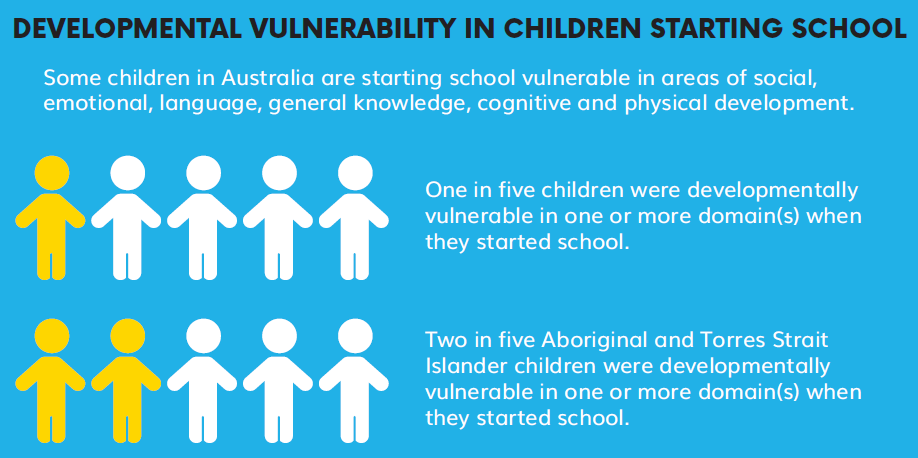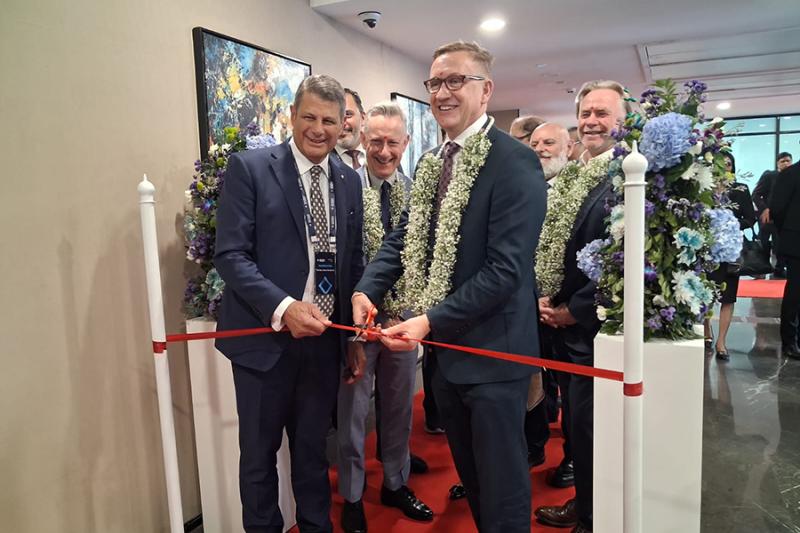New report on State of Early Learning in Australia

The Early Learning Everyone Benefits campaign has released a new report, State of Early Learning in Australia 2017, with analysis by Mitchell Institute policy fellows, Sarah Pilcher and Stacey Fox. This is the second report in a series that tracks progress across a range of different early childhood education and care outcome measures.
State of Early Learning in Australia 2017:
- provides a high-level snapshot of quality, participation and investment in ECEC in Australia
- highlights areas of improvement by state and territory governments and the Commonwealth
- expands upon existing datasets already publicly available
- brings together existing public data in a short and accessible format.
This report focuses on outcomes for Aboriginal and Torres Strait Islander children and children from disadvantaged backgrounds.

Text alternative to infographic: Developmental vulnerability in children starting school: Some children in Australia are starting school vulnerable in areas of social, emotional, language, general knowledge, cognitive and physical development. One in five children were developmentally vulnerable in one or more domains when they started school. Two in five Aboriginal and Torres Strait Islander children were developmentally vulnerable in one or more domains when they started school.
State of Early Learning in Australia snapshot
Child development
- The Australian Early Development Census (2016) data shows that in 2015 one in five Australian children were vulnerable in one or more key areas of development.
- Two in five Aboriginal and Torres Strait Islander children were vulnerable in one or more key area of development.
- Children from disadvantaged backgrounds are more than twice as likely to be developmentally vulnerable at the start of school.
- The effect of disadvantage is evident across all key areas of development, and is not changing over time.
- Overall there has been little change in the proportion of developmentally vulnerable Australian children since 2009.
Participation
- Across Australia in 2015:
- 35 per cent of children aged birth to two years participated in early education and care.
- 62 per cent of three-year-olds participated in early education and care.
- 89 per cent of four-year-olds are enrolled in preschool.
International comparisons
- Australia ranks below the OECD average for the participation of three-year-olds in ECEC.
- Australia also ranks below the OECD average for the participation of four-year-olds in ECEC, though has had the fastest growth of any OECD country over the past decade.
Progress towards national target for preschool enrolment
- At 91 per cent in 2015, Australia was within reach of the participation target set by the National Partnership Agreement - 95 per cent of children enrolled in preschool for 15 hours or more per week in the year before full-time school.
- All states and territories, apart from New South Wales, met the 95 per cent target in 2015.
- New South Wales, the most populous state in Australia, has only 77 per cent of its children participating in preschool for more than 15 hours per week in the year before full-time school in 2015, but this was up from 59 per cent in 2013.
Aboriginal and Torres Strait Islander children
- Aboriginal and Torres Strait Islander children are almost twice as likely as non-Aboriginal and Torres Strait Islander children to be developmentally vulnerable in four of the five areas of development.
- Aboriginal and Torres Strait Islander children are four times more likely to be developmentally vulnerable in language and cognitive skills.
- Enrolment rates of Aboriginal and Torres Strait Islander children in preschool programs in the year before full-time school still lag behind those of non-Aboriginal and Torres Strait Islander children in New South Wales and Queensland.
Quality
- At the end of March 2017, 88 per cent of services had been assessed against the NQF.
- 73 per cent of services now have a quality rating of meeting or above the NQS.
- Of the services that have been reassessed, 61 per cent received a higher rating on reassessment.
- In 2013, only 8 per cent of services were rated as 'exceeding' the NQS, by 2016 that figure had risen to 26.2 per cent.
- Some services continue to sit outside the NQF including Budget Based Funded (BBF) services and government-run preschools in Tasmania and Western Australia.
Workforce
- The number of qualified early childhood professionals continues to increase, with 16.6 per cent of the workforce holding a Bachelor's degree in 2016, 43.5 per cent holding a Bachelor's degree in 2016, 43.5 per dent holding a Diploma or Advanced Diploma and 40 per cent holding a Certificate III or IV.
Sector
- At the end of March 2017 there were 15, 593 ECEC services operating in Australia, of which 11,200 provide services to children in the years before school.
- Of those, 63 per cent were long day care centres, 28 per cent were preschools or kindergartens and 9 per cent were family day care centres.
- Long day care centres are the most common provider type in all states and territories except South Australia.
Investment
- Total Commonwealth, state and territory government expenditure on ECEC services was $9.1 billion in 2015-16, compared with $8.8 billion in 2014-15.
- Of this, Commonwealth Government expenditure accounted for $7.4 billion (82.1 per cent) delivered mainly through the childcare subsidy system and National Partnership Agreement.
- Commonwealth Government spending on early childhood services has grown rapidly over the past decade. Rising from $2.9 billion in 2006-07 to $7.4 billion in 2015-16.
- State and territory government spending on early childhood services has also seen a general upwards trend, however it should be noted this has included funding received from the Commonwealth through the National Partnership Agreement.
- State and territory government expenditure in 2015-16 accounted for $1.6 billion, with preschools accounting for 83 per cent of that expenditure.
- Western Australia and South Australia spend the greatest proportion of total budget expenditure on early childhood services at 1.2 per cent. New South Wales spends the lowest proportion, at only 0.4 per cent.
- When it comes to per child spending on early childhood services, the Northern Territory spends the most, at $1116 per child aged birth to 12 years. Again, New South Wales spends the least, with $246 per child.



